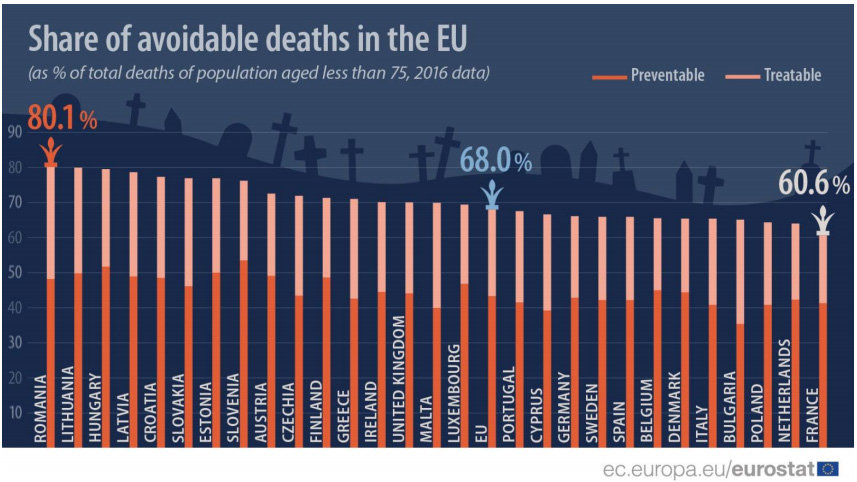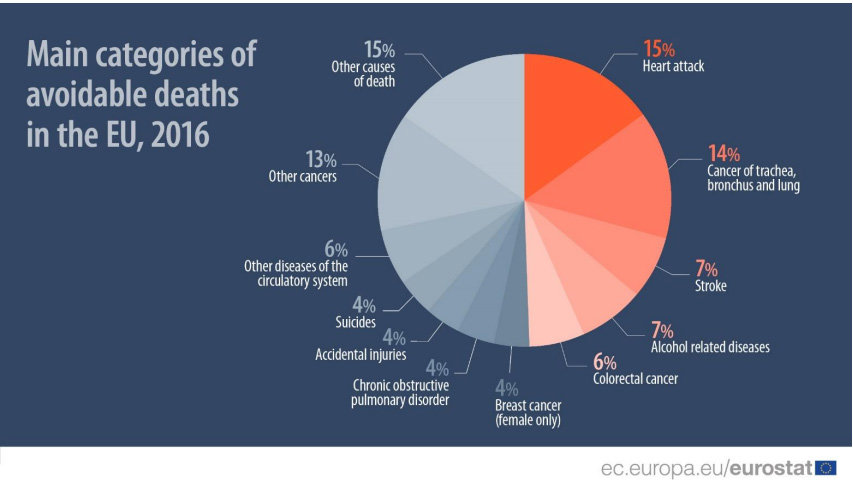For people under 75 years old, almost 3 out of 4 deaths occurred in Finland could be considered as premature, according to the recently developed Eurostat-OECD list of avoidable mortality.
The study, which analyzed causes of death across the European Union (EU) in 2016, shows that in Finland there were 12,816 potentially avoidable deaths of persons under 75 years old, this is 71.3% of total deaths. Among them, 8,737 (or 48.6%) could be considered as "premature" and 4,079 (22.7%) as "treatable", according to the statistical office of the EU.
In this report, the concept of avoidable mortality is based on the idea that certain deaths (for specific age groups and from specific diseases) could be "avoided", meaning that they would not have occurred at this stage if there had been effective public health and primary prevention interventions and/or timely and effective health care in place.

Most common causes
In the whole European Union (EU), about 1.7 million persons aged less than 75 died in 2016. Among them, around 1.2 million deaths could be considered as premature. Out of those, 741 000 preventable deaths could have been avoided through effective public health and primary prevention interventions, and 422,000 treatable deaths through timely and effective health care interventions.
Heart attacks (174 000 deaths), cancers of the trachea, bronchus and lung (168 000 deaths) and strokes (87 000) accounted together for over a third (37%) of total avoidable causes of death of people aged less than 75.
They were followed by alcohol related diseases (79,000 or 7%), colorectal cancers (67,000 or 6%), breast cancers and chronic obstructive pulmonary disorders (both 50,000 or 4%), accidental injuries (48,000 or 4%) and suicides (44,000 or 4%).

In Finland, causes of premature death for people in working age (15 to 64 years) were not very different in 2016 than in the rest of Europe. According to Statistics Finland, the most common were neoplasms, diseases of the circulatory system, alcohol related diseases and accidental poisoning by alcohol, accidents and suicides.
Compared to 2011, avoidable deaths as a share of total deaths decreased by 1.7 percentage points, from 69.7% of total deaths in 2011 to 68% in 2016.
Highest and lowest shares by country
The proportions of potentially avoidable deaths through effective public health and primary prevention interventions vary considerably between EU Member States.
The highest shares of preventable deaths were registered in Slovenia (53.5%) and Hungary (51.7%), followed by Estonia (50.0%), Lithuania (49.8%), Austria (49.1%) and Latvia (48.9%). In contrast, the share was lowest in Bulgaria (35.4%), ahead of Cyprus (39.2%), Malta (39.9%), Italy and Poland (both 40.8%).
The largest shares of treatable deaths were registered in Romania (31.9%) and Slovakia (30.8%), followed by Lithuania (30.1%), Malta (30.0%), Bulgaria and Latvia (both 29.7%). In contrast, the share was lowest in France (19.3%), ahead of Belgium (20.5%), Denmark (21.0%) and the Netherlands (21.7%).












